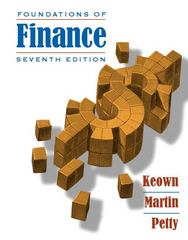Answered step by step
Verified Expert Solution
Question
1 Approved Answer
Question:Q1:Index Models:Version A: Download 61 months (September 2013 to September 2018) of monthly data for the SPDR S&P 500 Index ETF (symbol = SPY). Download
Question:Q1:Index Models:Version A:
Download 61 months (September 2013 to September 2018) of monthly data for the SPDR S&P 500 Index ETF (symbol = SPY). Download 61 months (September 2013 to September 2018) of Apple Inc. data (symbol = AAPL) and 61 months (September 2013 to September 2018) of Berkshire Hathaway Inc. data (symbol = BRK-B). Download 61 months (September 2013 to September 2018) of iShares 1-3 Year Treasury Bond ETF data (symbol = SHY).Be sure to use end-of-month data!Construct the following on a spreadsheet:
- Calculate 60 months of returns for the SPDR S&P 500 Index ETF, Apple, Berkshire Hathaway, and the iShares 1-3 Year Treasury Bond ETF. (Please compute simple monthly returns not continuously compounded returns.) Use October 2013 to September 2018. Note this means you need price data for September 2013. On the excel sheet report the average monthly returns for the SPDR S&P 500 Index ETF, Apple, Berkshire Hathaway, and the iShares 1-3 Year Treasury Bond ETF.
- Calculate excess returns for the SPDR S&P 500 Index ETF, Apple and Berkshire Hathaway. Use the monthly returns on the iShares 1-3 Year Treasury Bond ETF as your monthly risk-free return. On the Excel sheet report the average monthly excess returns for the SPDR S&P 500 Index ETF, Apple and Berkshire Hathaway.
- Regress excess Apple returns on the excess SPDR S&P 500 Index ETF returns and report, on the Excel sheet, , , the r-square and whether and are different from zero at the 10% level of significance. Briefly explain your inference.
- Use equation 8.10 to decompose total risk for Apple into systematic risk and firm-specific risk. That is, calculate total risk, systematic risk and firm-specific risk for Apple.
- Regress excess Berkshire Hathaway returns on the excess SPDR S&P 500 Index ETF returns and report, on the excel sheet, , , the r-square and whether and are different from zero at the 10% level of significance. Briefly explain your inference.
- Use equation 8.10 to decompose total risk for Berkshire Hathaway into systematic risk and firm-specific risk. That is, calculate total risk, systematic risk and firm-specific risk for Berkshire Hathaway.
- Use equation 8.10 to estimate the covariance and correlation of Apple and Berkshire Hathaway excess returns.
Step by Step Solution
There are 3 Steps involved in it
Step: 1

Get Instant Access to Expert-Tailored Solutions
See step-by-step solutions with expert insights and AI powered tools for academic success
Step: 2

Step: 3

Ace Your Homework with AI
Get the answers you need in no time with our AI-driven, step-by-step assistance
Get Started


